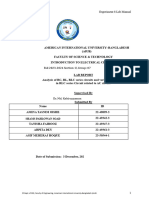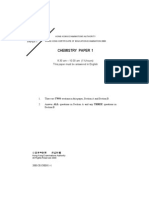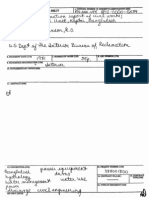Iec Lab - Exp 08
Iec Lab - Exp 08
Uploaded by
moon06908Copyright:
Available Formats
Iec Lab - Exp 08
Iec Lab - Exp 08
Uploaded by
moon06908Original Title
Copyright
Available Formats
Share this document
Did you find this document useful?
Is this content inappropriate?
Copyright:
Available Formats
Iec Lab - Exp 08
Iec Lab - Exp 08
Uploaded by
moon06908Copyright:
Available Formats
Experiment 8 Lab Manual
American International University- Bangladesh
Department of Electrical and Electronic Engineering
EEE 2109: Introduction to Electrical Circuits Laboratory
Title: Analysis of RC, RL, RLC series circuits and verification of KVL in RLC series Circuit.
Abstract:
The purpose of this experiment is to develop an understanding of circuits containing R,L and
C components and also is to be able to analyze the outputs of RC & RL series circuit obtained
practically with simulated or theoretical results along with the determination of phase
relationship between V and I in an RLC series circuit and finally to draw the complete vector
diagram of an RLC series circuit which is designed and where KVL is verified in this
experiment.
Introduction:
The RC & RL circuit is used to determine the input and output relationship of voltage and
current for different frequencies. In RC series circuit the voltage lags the current by 90˚and in
RL series circuit the voltage leads the current by 90˚.
An RLC circuit is an electrical circuit consisting of a resistor, an inductor, and a capacitor,
connected in series. The RLC part of the name is due to those letters being the usual electrical
symbols for resistance, inductance and capacitance respectively. Series RLC circuits are
classed as second-order circuits because they contain two energy storage elements, an
inductance and a capacitance.
The primary objectives of the lab experiment are-
• To determine the reactance of the RL and RC circuits and the impedance equation
both practically and theoretically.
• To determine phase relationship between voltage and current in an RLC circuit.
• To draw the complete vector diagram.
• Design an RLC series circuit and verify KVL.
Theory and Methodology:
RC Series Circuit:
A resistor–capacitor circuit(RC circuit), or RC network, is an electric circuit composed of
resistors and capacitor is in series driven by a voltage or current source(See the Figure-1).
A first order RC circuit is composed of one resistor and one capacitor and is the simplest
type of RC circuit.
© Dept. of EEE, Faculty of Engineering, American International University-Bangladesh (AIUB 1
Experiment 8 Lab Manual
Figure 1
Analysis of a Series RC Circuit:
For doing a complete analysis of a series RC circuit, given the values of R, C, f, and VT.
Step 1. Calculate the value of XC:
XC = 1 / (2πfC)
Step 2. Calculate the total impedance Z:
𝑍 = √(𝑋𝑐2 + 𝑅2)
Step 3. Use Ohm's Law to calculate the total current IT:
IT = VT / Z
Difference between Rectangular & Polar representation of Impedance:
• In Rectangular form:
ZT = R - j XC
• In Polar form:
ZT = √𝑅2 + (𝑋𝑐)2
θ = tan-1(-XC/R) = tan-1(-1/ωRC)
Impact of frequency on the value of capacitance:
Figure 1.1 will shows the impact of frequency by varying the value of Capacitance in series
resonance.
© Dept. of EEE, Faculty of Engineering, American International University-Bangladesh (AIUB 2
Experiment 8 Lab Manual
Figure 1.1
RL Series Circuit:
A resistor–inductor circuit (RL circuit), or RL network, is an electric circuit composed of
resistors and inductor is in series driven by a voltage or current source (See the Figure-2).
A first order RL circuit is composed of one resistor and one inductor and is the simplest
type of RL circuit
Figure 2
Analysis of a Series RL Circuit:
For doing a complete analysis of a series RL circuit, given the values of R, L, f, and VT.
Step 1. Calculate the value of XL:
XL = 2πfL
Step 2. Calculate the total impedance Z:
𝑍 = √(𝑋𝐿2 + 𝑅2)
© Dept. of EEE, Faculty of Engineering, American International University-Bangladesh (AIUB 3
Experiment 8 Lab Manual
Step 3. Use Ohm's Law to calculate the total current IT:
IT = VT / Z
Difference between Rectangular & Polar representation of Impedance:
• In Rectangular form:
ZT = R+jXL
• In Polar form:
ZT = √𝑅2 + (𝑋𝐿)2
θ = tan-1(XL /R) = tan-1(ωL/R)
Impact of frequency on the value of inductance:
Figure 2.1 will shows the impact of frequency by varying the value of Inductance in series
resonance.
Figure 2.1
RLC Series Circuit:
Three basic passive components- R, L and C have very different phase relationships to each
other when connected to a sinusoidal AC supply. In case of a resistor the voltage waveforms
are "in-phase" with the current. In case of pure inductor, the voltage waveform "leads" the
current by 90o whereas in case of pure capacitor, the voltage waveform "lags" the current by
90o. This phase difference depends upon the reactive value of the components being used.
Reactance is zero if the element is resistive, positive if the element is inductive and negative
if the element is capacitive.
Instead of analyzing each passive element separately, we can combine all three together into
a series RLC circuit. The analysis of a series RLC circuit is the same as that for the dual
© Dept. of EEE, Faculty of Engineering, American International University-Bangladesh (AIUB 4
Experiment 8 Lab Manual
series RL and RC circuits we studied in the last experiment, except this time we need to take
account the magnitudes of both inductive reactance and capacitive reactance to find the
overall circuit reactance.
Figure 3: RLC series circuit
Relevant Equations:
Inductive reactance, XL = 2пfL
1
Capacitive reactance, XC =
2п𝑓𝐶
Net reactance, X = XL - XC
Total impedance, Z = √𝑅2 + 𝑋2
Current, I = 𝑉
𝑍
Resistive voltage drop, VR = I*R
Reactive voltage drops = VL – VC, where VL = I*XL and VC = I*XC
Total voltage drop = √𝑉𝑅2 + (𝑉𝐿 − 𝑉𝐶)2
Vector Diagram:
© Dept. of EEE, Faculty of Engineering, American International University-Bangladesh (AIUB 5
Experiment 8 Lab Manual
Pre-Lab Homework:
Read about the characteristics of RC, RL and RLC series circuit from “Alternating Current
Circuit” by George F Corcoran and use PSIM to generate the output of the circuits provided
in this lab sheet. Compare the wave shapes given in the text book with your results. Save the
simulation results and bring it to the lab.
Apparatus:
• Oscilloscope
• Function generator
• Resistor: 100 (For RC and RL)
• Inductor: 2.4mH (For RC and RL)
• Capacitor: 1 F/ 10 F (For RC and RL)
• SPST switch
• Resistor (200 ) For RLC
• Inductor (6.3 mH) For RLC
• Capacitor(1 uF) For RLC
• Connecting wire
• Bread board
Precautions:
• Oscilloscopes should be properly calibrated using the information provided at the
calibration port before obtaining the wave shapes using the experimental set up.
• Do not short any connections. Short connection can produce heat (due to high current
flow) which is harmful for the components.
Experimental Procedure:
For RC and RL Series Circuit:
1. Construct the circuit as shown in the Fig. 1. Connect channel 1 of the oscilloscope
across function generator and channel 2 of the oscilloscope across R.
2. Set the amplitude of the input signal 5V peak and the frequency at 1 kHz. Select
sinusoidal wave shape.
3. Measure peak value of the both wave shapes.
4. Determine phase relationship between the waves.
5. Write down the wave equations for I and E.
6. Calculate resistance and reactance from the relevant data.
7. Do the same experiment setting input frequency 5kHz and 10kHz.
8. Complete the following table.
Table~1
f E I=VR/R Z= E I Z R XC=1/2fC VR VC=IXC
(A) (Rectangular)
(Polar)
1KHz
5KHz
10KHz
© Dept. of EEE, Faculty of Engineering, American International University-Bangladesh (AIUB 6
Experiment 8 Lab Manual
1. Now construct the circuit as shown in fig.2. Connect channel 1 of the oscilloscope
across function generator and channel 2 of the oscilloscope across R.
2. Do the same procedure stated in 2 to 7. Complete the following table.
Table~2
f E I=VR/R Z= E I Z R XL=2fL VR VL=IXL
(A) (Rectangular)
(Polar)
1KHz
5KHz
10KHz
For RLC Series Circuit:
1. Construct the circuit as shown in the Figure 3. Connect channel 1 of the oscilloscope
across the ac voltage source and channel 2 of the oscilloscope across R.
2. Set the amplitude of the input signal 5V peak.
3. Set the frequency of the signal generator 1 kHz.
4. Determine phase relationship between the waves.
5. Measure value of I.
6. Measure value of VR, VL& VC.
7. Verify KVL using the experimental data and draw the complete vector diagram.
8. Set the frequency of the signal generator 2 kHz. Repeat step 4-7.
9. Set the frequency of the signal generator 4 kHz. Repeat step 4-7.
10. Complete the following table.
Table~3
f E θ = tan-1 VR I=VR/R XL=2fL VL=IXL XC=1/2fC VC V* Comment
(V) X/R (V) (A) () (V) () (V) (V)
1kHz
2kHz
4kHz
*V = √𝑉𝑅2 + (𝑉𝐿 − 𝑉𝐶)2
Simulation and Results:
Compare the simulation results with your experimental data/ wave shapes and comment on
the differences (if any). Example of how the simulated wave shape should look is provided
below.
Result and Calculation:
1. Complete Table~1 and Table~2 and Table~3.
2. Calculate the value of XC, XL, Z, I,θ.
3. Draw the complete vector diagram for the RL and RC and RLC circuit.
4. Comment on the role of frequency to inductive reactance and capacitive reactance.
© Dept. of EEE, Faculty of Engineering, American International University-Bangladesh (AIUB 7
Experiment 8 Lab Manual
Questions for report writing:
1. Draw the complete vector diagrams.
2. Verify KVL.
Discussion and Conclusion:
Interpret the data/findings and determine the extent to which the experiment was
successful in complying with the goal that was initially set. Discuss any mistake you
might have made while conducting the investigation and describe ways the study could
have been improved.
Reference:
[1] “Fundamental of Electric Circuit”by AlekzendreSadiku
[2] “Alternating Current Circuit” by George F Corcoran
[3] http://physics.bu.edu/~duffy/py106/ACcircuits.html
© Dept. of EEE, Faculty of Engineering, American International University-Bangladesh (AIUB 8
You might also like
- HydrostaticDocument9 pagesHydrostaticSWARAJ PAWARNo ratings yet
- Impedance of RC Circuits: Series RC Circuits: Experiment No. 3Document17 pagesImpedance of RC Circuits: Series RC Circuits: Experiment No. 3NicoNo ratings yet
- IEC 60502-2 (ed3.0.RLV) enDocument11 pagesIEC 60502-2 (ed3.0.RLV) envikivarma1470% (4)
- Iec Lab - Exp 08 - Fall 23-24Document8 pagesIec Lab - Exp 08 - Fall 23-24rakibulislamakash40No ratings yet
- IEC - EXP - 8 - Analysis of RC, RL, RLC Series Circuits and Verification of KVL in RLC Series Circuit Related To AC CircuitDocument8 pagesIEC - EXP - 8 - Analysis of RC, RL, RLC Series Circuits and Verification of KVL in RLC Series Circuit Related To AC Circuitsajid_hossain_60% (1)
- Iec Exp 8Document9 pagesIec Exp 8mursalinleon2295No ratings yet
- Experiment 2 Lab ManualDocument6 pagesExperiment 2 Lab ManualSikat Gabriel L.100% (1)
- GRP 07 Exp 08 IeclabDocument19 pagesGRP 07 Exp 08 IeclabesumshunNo ratings yet
- Electrical Circuit - 2Document35 pagesElectrical Circuit - 2arnabruet2004No ratings yet
- ImpedanceDocument3 pagesImpedanceknadityakarankotNo ratings yet
- Exp 8Document12 pagesExp 8esumshunNo ratings yet
- Postlab Report #3Document8 pagesPostlab Report #3Poyraz EmelNo ratings yet
- Laboratory Experiment No. 2Document16 pagesLaboratory Experiment No. 2johnpaul varonaNo ratings yet
- Aims of The Exercise: EquipmentDocument3 pagesAims of The Exercise: Equipmentwala alabedNo ratings yet
- Experiment 2Document6 pagesExperiment 2aira100% (1)
- Impedance of RL Circuits: Series RL Circuits: Experiment No. 2Document16 pagesImpedance of RL Circuits: Series RL Circuits: Experiment No. 2NicoNo ratings yet
- MUCLecture 2022 94268Document4 pagesMUCLecture 2022 94268M Hasnain KhanNo ratings yet
- MODULE EE 213 Week 13 17Document15 pagesMODULE EE 213 Week 13 17TUMICAD, ZAIREN CNo ratings yet
- Exp3 (Ac Series)Document2 pagesExp3 (Ac Series)Deepankar Synthesizer Playist DspNo ratings yet
- Experiment 6Document2 pagesExperiment 6Swaroop MallickNo ratings yet
- NT Lab ManualDocument39 pagesNT Lab ManualTomy JulieNo ratings yet
- Electrical Engineering DepartmentDocument10 pagesElectrical Engineering DepartmentNicoNo ratings yet
- Laboratory 2 BEEDocument11 pagesLaboratory 2 BEE22-03844No ratings yet
- Group5 - Laboratory No. 3Document13 pagesGroup5 - Laboratory No. 3Angel GonzalesNo ratings yet
- Basic Electrical EngineeringDocument37 pagesBasic Electrical EngineeringCharles SandersNo ratings yet
- Experiment No-4Document6 pagesExperiment No-4devanshurajpoot1No ratings yet
- ENA ManualDocument60 pagesENA ManualAbdul Munim100% (1)
- W7 Sfe3033 RL SVDocument24 pagesW7 Sfe3033 RL SVMuhammad Nurazin Bin RizalNo ratings yet
- Federal Urdu University of Arts, Science & Technology Islamabad - Pakistan Electrical EngineeringDocument50 pagesFederal Urdu University of Arts, Science & Technology Islamabad - Pakistan Electrical EngineeringMtanveer MunirNo ratings yet
- Linze LowDocument5 pagesLinze Lowabdurrahman.nahseniNo ratings yet
- Laboratorio 4 FisicaDocument15 pagesLaboratorio 4 FisicaAlejandro RodriguezNo ratings yet
- Circuit and Network Theory Lab ReportDocument8 pagesCircuit and Network Theory Lab Reportpeaceissa695No ratings yet
- Experiment No. 4-Parallel RC and RL CircuitsDocument9 pagesExperiment No. 4-Parallel RC and RL CircuitsArct John Alfante Zamora100% (1)
- First Set PDF 2018-19 PDFDocument22 pagesFirst Set PDF 2018-19 PDFLavankumar MudirajNo ratings yet
- AP Physc em R L Circuit Lab 2014-06-06Document9 pagesAP Physc em R L Circuit Lab 2014-06-06黃吏維No ratings yet
- BERT 1333 - LAB2 Sem2 2023 - 24Document12 pagesBERT 1333 - LAB2 Sem2 2023 - 24Aina BalqisNo ratings yet
- Assignment 1Document11 pagesAssignment 1ilkay KOZAKNo ratings yet
- Inductive Reactance (In RL Circuits) : FALL2020: CNET219Document6 pagesInductive Reactance (In RL Circuits) : FALL2020: CNET219liam butlerNo ratings yet
- Experiment No - 5 - UpdatedDocument11 pagesExperiment No - 5 - Updatedaadityagadwal03No ratings yet
- Exp11.Three Phase Full Wave Controlled ConvertersDocument4 pagesExp11.Three Phase Full Wave Controlled ConvertersJawad Rasheed SheikhNo ratings yet
- CAD Exp2Document8 pagesCAD Exp2ahad mushtaqNo ratings yet
- Department of Mechanical Engineering COURSE NO: EECE160 (Fundamental of Electrical Engineering Sessional)Document3 pagesDepartment of Mechanical Engineering COURSE NO: EECE160 (Fundamental of Electrical Engineering Sessional)thasan11No ratings yet
- LAB BeeDocument16 pagesLAB Bee22-03844No ratings yet
- Lab 2 RLC CircuitDocument12 pagesLab 2 RLC CircuitJustin WesleyNo ratings yet
- Lab 06 RC, RL, and RLC Transients-2Document11 pagesLab 06 RC, RL, and RLC Transients-2Ece KayaNo ratings yet
- Exp 5 and 6Document6 pagesExp 5 and 6MOHAMMED ARHAMNo ratings yet
- Experiment Name-Study of Wein Bridge OscillatorDocument2 pagesExperiment Name-Study of Wein Bridge Oscillatormrana_56100% (1)
- AE Manual GECR PDFDocument105 pagesAE Manual GECR PDFhimadrimandal2006No ratings yet
- Bee Exp-7Document5 pagesBee Exp-7muthusamthevarNo ratings yet
- Class Session FileDocument5 pagesClass Session FileLara MaxNo ratings yet
- Laboratory Manual For Ac Electrical CircuitsDocument80 pagesLaboratory Manual For Ac Electrical CircuitsAngelo Palaming100% (1)
- RLC Series CircuitDocument4 pagesRLC Series CircuitManzar AliNo ratings yet
- DC Lab - Exp - 2Document6 pagesDC Lab - Exp - 2THE LEARNER GAMINGNo ratings yet
- ECE 2201 Experiment 1 - 4Document13 pagesECE 2201 Experiment 1 - 4Deepak SharmaNo ratings yet
- Power ElectronicsDocument83 pagesPower ElectronicsSreekanth SurendrenNo ratings yet
- Laboratory Manual For Ac Electrical CircuitsDocument90 pagesLaboratory Manual For Ac Electrical CircuitsLharie Mae BecinaNo ratings yet
- Experiment 3Document2 pagesExperiment 3Swaroop MallickNo ratings yet
- DC Lab Exp 2 Student Manual (Fall 22-23)Document6 pagesDC Lab Exp 2 Student Manual (Fall 22-23)Ratul kumarNo ratings yet
- Circuits 2 Laboratory L31A: ScoreDocument20 pagesCircuits 2 Laboratory L31A: ScoreNicoNo ratings yet
- Monday Thermodynamic (Assignment)Document5 pagesMonday Thermodynamic (Assignment)abdulmajeedabdussalam09No ratings yet
- Data Sheet G08101374 Dussan PDFDocument2 pagesData Sheet G08101374 Dussan PDFWilliam AlvaradoNo ratings yet
- Eucon 537 MSDocument1 pageEucon 537 MSpravi3434No ratings yet
- MTAVC-0 2 0-ManualDocument6 pagesMTAVC-0 2 0-ManualStephanie CurryNo ratings yet
- Tss HospitalDocument12 pagesTss Hospitalbharath venugopal rao tamarapalliNo ratings yet
- TRAC-40GN Tandem Specs-1000units-REF077-20221004 (OP2)Document2 pagesTRAC-40GN Tandem Specs-1000units-REF077-20221004 (OP2)nguyennguyen05072000No ratings yet
- C A S E 1: When Liquid & Gas Flows Are Given Use This Row. GOR & WC Are Not NeededDocument8 pagesC A S E 1: When Liquid & Gas Flows Are Given Use This Row. GOR & WC Are Not NeededJSN179No ratings yet
- Advantages S7-1200 To S7-200Document35 pagesAdvantages S7-1200 To S7-200Jesus CayoNo ratings yet
- Lexandria Niversity Faculty of Engineering: ObjectivesDocument4 pagesLexandria Niversity Faculty of Engineering: ObjectivesMohamed OssamaNo ratings yet
- Carman Scan VG+Document2 pagesCarman Scan VG+alajrassNo ratings yet
- RRR 8 DDocument401 pagesRRR 8 DRafi UdeenNo ratings yet
- Robotics Part 1Document24 pagesRobotics Part 1Gour Ig100% (1)
- Characteristic Strength (FCK)Document3 pagesCharacteristic Strength (FCK)swaroop87No ratings yet
- Euler-Bernoulli Beam Theory - Simple English Wikipedia, The Free EncyclopediaDocument2 pagesEuler-Bernoulli Beam Theory - Simple English Wikipedia, The Free EncyclopediaCordy Jourvel Itoua-TseleNo ratings yet
- 2017 BG CatalogueDocument200 pages2017 BG Catalogueazeemahmedkhan021No ratings yet
- 365a TieriiiDocument2 pages365a TieriiiAkhmad SebehNo ratings yet
- Chemistry 2000 Paper 1+ansDocument13 pagesChemistry 2000 Paper 1+ansapi-38240030% (2)
- Nominal Performance: Hermetic Compressor Model: Aw 2495Zk-P BOM ID: 972-A1Document1 pageNominal Performance: Hermetic Compressor Model: Aw 2495Zk-P BOM ID: 972-A1Zikko FirmansyahNo ratings yet
- CH 3 Deisgn Formulae For Shear, Deflection and BondDocument29 pagesCH 3 Deisgn Formulae For Shear, Deflection and Bond秦瑋駿No ratings yet
- Bulk Density ("Unit Weight") and Voids in Aggregate: Standard Test Method ForDocument4 pagesBulk Density ("Unit Weight") and Voids in Aggregate: Standard Test Method ForEdmundo Jaita CuellarNo ratings yet
- 25KW-50KW SafetyDocument2 pages25KW-50KW Safetysol indiaNo ratings yet
- Excerpts Taken From Asme Boiler and Pressure Vessel CodeDocument3 pagesExcerpts Taken From Asme Boiler and Pressure Vessel Codeஅன்புடன் அஸ்வின்No ratings yet
- Examination Report - SH DamDocument59 pagesExamination Report - SH DamsarvannnNo ratings yet
- USS Manual, Rev. A PDFDocument192 pagesUSS Manual, Rev. A PDFsantiago castañedaNo ratings yet
- The Haunted HouseDocument2 pagesThe Haunted HousezainaNo ratings yet
- Complexity Space N TimeDocument36 pagesComplexity Space N Timeapi-3814408100% (4)
- IB 70-8738.rev2. Feb 2011 PDFDocument12 pagesIB 70-8738.rev2. Feb 2011 PDFoktaykeskin1No ratings yet
- RecommendationreportDocument6 pagesRecommendationreportapi-301893823No ratings yet
- Sysmex Corporation Application Form IITB 2Document4 pagesSysmex Corporation Application Form IITB 2abhishek65cNo ratings yet

























































































